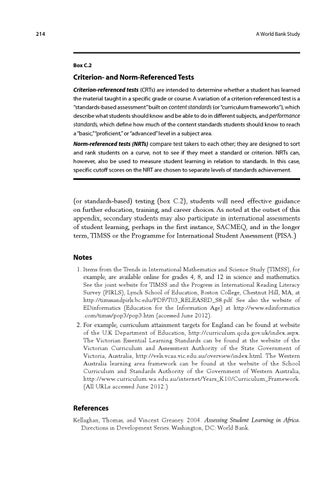214
A World Bank Study
Box C.2
Criterion- and Norm-Referenced Tests Criterion-referenced tests (CRTs) are intended to determine whether a student has learned the material taught in a specific grade or course. A variation of a criterion-referenced test is a “standards-based assessment” built on content standards (or “curriculum frameworks”), which describe what students should know and be able to do in different subjects, and performance standards, which define how much of the content standards students should know to reach a “basic,” “proficient,” or “advanced” level in a subject area. Norm-referenced tests (NRTs) compare test takers to each other; they are designed to sort and rank students on a curve, not to see if they meet a standard or criterion. NRTs can, however, also be used to measure student learning in relation to standards. In this case, specific cutoff scores on the NRT are chosen to separate levels of standards achievement.
(or standards-based) testing (box C.2), students will need effective guidance on further education, training, and career choices. As noted at the outset of this appendix, secondary students may also participate in international assessments of student learning, perhaps in the first instance, SACMEQ, and in the longer term, TIMSS or the Programme for International Student Assessment (PISA.)
Notes 1. Items from the Trends in International Mathematics and Science Study (TIMSS), for example, are available online for grades 4, 8, and 12 in science and mathematics. See the joint website for TIMSS and the Progress in International Reading Literacy Survey (PIRLS), Lynch School of Education, Boston College, Chestnut Hill, MA, at http://timssandpirls.bc.edu/PDF/T03_RELEASED_S8.pdf. See also the website of EDinformatics (Education for the Information Age) at http://www.edinformatics .com/timss/pop3/pop3.htm (accessed June 2012). 2. For example, curriculum attainment targets for England can be found at website of the U.K Department of Education, http://curriculum.qcda.gov.uk/index.aspx. The Victorian Essential Learning Standards can be found at the website of the Victorian Curriculum and Assessment Authority of the State Government of Victoria, Australia, http://vels.vcaa.vic.edu.au/overview/index.html. The Western Australia learning area framework can be found at the website of the School Curriculum and Standards Authority of the Government of Western Australia, http://www.curriculum.wa.edu.au/internet/Years_K10/Curriculum_Framework. (All URLs accessed June 2012.)
References Kellaghan, Thomas, and Vincent Greaney. 2004. Assessing Student Learning in Africa. Directions in Development Series. Washington, DC: World Bank.
